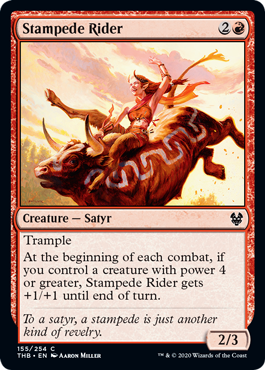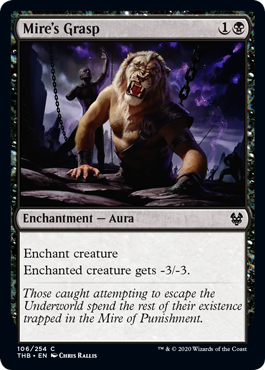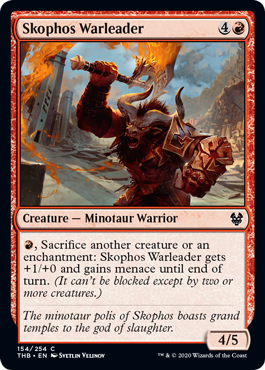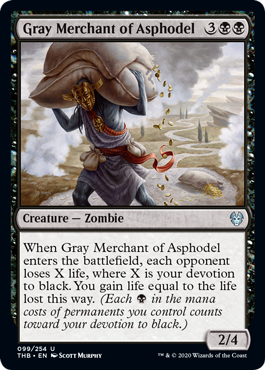To the Death
It's time to start telling card-by-card design stories from Theros Beyond Death. Sit back and rest your feet as I tell a tale or two.
Anax, Hardened in the Forge, The First Iroan Games, Furious Rise, Ilysian Caryatid, Nessian Hornbeetle, Stampede Rider, and Warden of the Chained







One of the challenges of designing a set is making sure you have mechanical themes for all your Draft archetypes. Which colors or combination of colors end up being your archetypes depends a lot on the larger themes of your set. Theros Beyond Death, for example, has a monocolor focus, with devotion, and then provides Draft archetypes for each of the two-color combinations.
When figuring out what each of your Draft archetypes does, you tend to start by looking at your new mechanics and themes and seeing which ones make sense in which colors. Your new mechanics won't stretch to fill all ten two-color pairs, so that means you have to work to add some themes to the color combinations you have left. Usually what you do is find a theme that plays into normal Magic as well as the set's themes that can be easily written onto a handful of cards. The theme isn't keyworded, because it's just on a handful of cards and cares about something that's pretty straightforward. The cards above are a good example.
In Theros Beyond Death Booster Draft, red and green have a "power 4 or greater theme" where it encourages you to get out a bigger creature onto the battlefield. Each of the cards with the theme have a normal function but give you extra value if you manage to cast a creature with power 4 or greater.
Arena Trickster, Dreamstalker Manticore, Mischievous Chimera, Stinging Lionfish, and Wavebreak Hippocamp





A similar non-keyworded theme shows up in blue and red with "whenever you cast your first spell during an opponent's turn." Blue and red are naturally the two colors that care most about spells. (Blue has the most spells of any color at 50%, and red is number two at 47%.) It's very common for blue and red to have a spells-matter theme, but the Theros Beyond Death design team wanted to put a little twist on it. By caring about your spells being played on the opponent's turn, it puts a focus on instants (eight in blue and four in red) and permanents with flash (seven in blue and two in red).
Ashiok's Erasure and Mire's Grasp


The designs of these two cards offer an excellent look into one of the challenges of designing an enchantment-heavy set. Whenever you do a "_____s matter" set, you start by tackling the numbers issue. In order to make the theme matter in either Limited or Constructed, you have to up the number of cards that are the thing you care about.
For Limited, it's what we call an as-fan issue. As-fan stands for "as-fanned" and concerns how often something shows up if you fan an average booster pack. Solving Limited means getting as high of an as-fan in your theme as your set can comfortably hold. As-fan issues are usually solved at common as they make up the vast majority of the cards in a booster.
For Constructed, it's what we call an as-played issue. You don't care how many cards have the quality as much as you care about how many tournament-viable cards have the quality. You could, for example, have a low as-fan but a high as-played if you focus a bunch of your best cards on the theme. Likewise, you could have a high as-fan but a low as-played if your set has a lot of cards in the theme but none powerful enough for Constructed.
There are two major tricks to solve the as-fan and as-played issues.
The first trick is to have creatures that can be of the wanted thing. Creatures tend to make up a majority of decks, and having some of them count as the thing you need is huge. Making an artifact set, for example? Have a lot of artifact creatures. This is why enchantment creatures are so crucial to making Theros sets work. Enchantment creatures alone, though, aren't enough.
The second trick is to turn slots that you would normally have into the thing you need. The two cards above are a great example of this. For example, many sets would have a common black instant or sorcery that gives target creature -3/-3 until end of turn. In an enchantment-focused set, that card is much better as an aura. You can still use it to kill a 3-toughness creature, but now you're triggering your constellation cards and can regrow it with enchantment retrieval. Mire's Grasp does the work that the slot would normally do while adding in extra value for your enchantment theme.
Ashiok's Erasure is a little subtler in its design but meets the same criteria from a Constructed vantage. Let's say you're trying to get extra blue cards in your enchantment-focused deck. Ashiok's Erasure is basically a counterspell, but rather than being an instant, it's an enchantment.
In both Mire's Grasp and Ashiok's Erasure, the spell's value as an enchantment goes beyond its interaction with enchantments. For example, Mire's Grasp can now be used to shrink a larger creature permanently (well, until the enchantment is removed). This isn't a functionality the instant or sorcery would have. Likewise, Ashiok's Erasure doesn't just stop the one spell but can stop all other copies of that spell.
It's designs like these two cards that allowed the design team to shape an enchantments-matter set.
Atris, Oracle of Half-Truths

If you asked me what set had the most ideas ahead of its time smashed into it, I'd say Alliances. The set is full of single cards that do cool things, previously never before seen, that would later be realized in other designs. One such thing is something R&D refers to as "divvy."
Divvying is when a card asks one player to get a number of cards and split them into two piles. The other player then picks one of the two piles, and something is done with that pile. Phyrexian Portal from Alliances was the first card to use divvying, but it was far from the last. Invasion used divvy as a small theme on six cards, including one card that officially put divvy on the map:
Randy Buehler had just started working at Wizards, and his first set to develop was Invasion. Bill Rose, Mike Elliott, and I had designed the divvy cards (I have no idea if we were inspired by Phyrexian Portal), and Randy took a liking to Fact or Fiction. It was a great Spike card, and Randy was a huge Spike. He really enjoyed how it played, so he pushed the power level, and the card ended up being very strong when it was printed.
The card went on to get played a lot, and, just like with Randy, it became a Spike favorite. So much so that it's inspired numerous designs over the years, including Atris. The one new tweak that Atris brings to the table is having one of the piles being turned face down so there's an element of bluffing built into it. It's one of the cards I've had the most fun playing with the finished set.
Blood Aspirant, Dreamshaper Shaman, Final Flare, Skophos Warleader, and Slaughter-Priest of Mogis





One of the things that happened during Theros Beyond Death design is that the Council of Colors met to talk about the color pie and its interaction with enchantments. Whenever we focus on a particular theme, we like to examine the color pie to figure out where we can let each color interact. One of the troublesome colors was red. Red doesn't destroy enchantments. It doesn't tutor for enchantments from the library (to the hand), it doesn't bring enchantments back from the graveyard. It's just the color that had the least overlap with the card type.
So, the question was raised in the meeting. What could red do with enchantments? After some discussion, we found a space that wasn't strongly taken by any color that we felt we could give to red—sacrificing enchantments. While red had trouble getting rid of the opponent's enchantments, we decided we were okay with it being to get rid of its own. We chose specifically not to do this in black, because we like making the "deal with the devil" enchantments in black and didn't want to make it too easy for black to get rid of them.
Once red had this ability, we could then pair it up with black, which is good at sacrificing creatures, to make a black-red sacrifice archetype for Limited play. This isn't something I expect to see red do a lot as it requires an environment with enough enchantments to warrant it, but it's now a new tool in red's toolbox.
Calix, Destiny's Hand

Tezzeret's theme as a planeswalker is to mechanically care about artifacts. Saheeli's theme as a planeswalker is to mechanically care about artifacts. Daretti's theme as a planeswalker is to mechanically care about artifacts. Karn is an artifact (although not technically in game terms, as planeswalkerness overrides other qualities) and also cares about artifacts. Nahiri is a planeswalker that mechanically cares about equipment, which is a subtype of artifacts. Dack Fayden was a planeswalker that stole artifacts. Teferi could untap and regrow artifacts. Elspeth could make artifacts indestructible. Dovin made artifact creatures. There's a lot of overlap between planeswalkers and artifacts.
How about enchantments?
Teferi could regrow enchantments, and Elspeth could make them indestructible. Both are things they could also do with artifacts. It wasn't until Commander (2018 Edition), less than two years ago, that a planeswalker even existed whose focus was caring about enchantments. Her name was Estrid, the Masked.
For Theros Beyond Death, we wanted a planeswalker that cared about enchantments. Our first thought was Estrid, because well, that's really all we had, but we were told by the Creative team that she didn't flavorfully make sense for the Theros Beyond Death story. So, we really had no other choice than to make a new one.
The color choice was pretty obvious as we didn't want more than two colors—green and white, as those are the two colors most focused on enchantments. The idea was that everything about this planeswalker would be caring about enchantments. His first ability, the positive loyalty one, taps into green, and a little white, to help you draw more enchantments. By just focusing on a small number of cards on top of your library, it heavily encourages you to play an enchantment-heavy deck.
The ultimate was designed next. What's a very strong thing you could do with enchantments? Well, back in Urza's Destiny, I made a strong enchantment-themed card called Replenish.
Urza's Saga block had an enchantment theme (yeah, it got overshadowed by the broken artifacts), so I designed Replenish to be an enchantment build-around card. It worked, and Replenish decks were very popular for a while. Replenish seemed like a great effect for an ultimate.
That left the middle ability. What's something we tend to like for the small minus loyalty ability? Something that can help deal with threats on the battlefield. How could we do that while being focused on enchantments? Was there an enchantment that did a good job of doing what we needed? Yes, Oblivion Ring.
First appearing in Lorwyn, Oblivion Ring proved to be a great universal answer for white. What if Calix could turn any of your enchantments into an Oblivion Ring. That would help solve board issues while still being enchantment centric.
I'm happy with how the card all came together and glad that enchantments finally get a second planeswalker to look up to.
Discordant Piper and Woe Strider


Among other things, Theros Beyond Death will be the first set to ever have two cards in it that create Goat creature tokens (they're 0/1 white creatures). The history of Goats is a funny one, so I thought I'd use this column to tell the story. The very first Goats showed up in early Magic as a creature type.
Ice Age, back in 1995, had Mountain Goat, a 1/1 mountainwalker. It was then redone in Portal Three Kingdoms as Zodiac Goat a couple years later. And then no Goats for years. During that time, though, I used to get letters from a fan who wanted more Goats. They were pretty persistent for a while. So much so that I used to joke with the rest of R&D that we needed to make more Goats because I kept getting letters from the "Goat Guy." (I don't actually know if it was a man, but the name stuck.)
In Lorwyn, we made the changeling mechanic. Someone thought it would be funny to make the following card:
Because of Mountain Goat and Zodiac Goat, Goat was a supported creature type, so Goatnapper affected all the creatures with changeling. I argued that I thought it was funny, but we really should have one Goat. If not, I'd get a lot of letters about why there was a Goatnapper but no Goat. (And by the way, I did, quite a lot.) The rest of R&D thought it was funnier with no Goat. While I couldn't get any Goats in Lorwyn, I did manage to make a Goat card later in the block in Eventide. The card already existed. It was a card with chroma (aka proto-devotion) that made 0/1 white creature tokens equal to your white mana symbols. It needed to be something, so I chose to make it Goats. It stuck, and 0/1 white creature tokens started becoming Goats, showing up on various cards including both Discordant Piper and Woe Strider in Theros Beyond Death. Hope you're happy, Goat Guy (or Goat Gal).
Elspeth, Sun's Nemesis

When we first decided to return to Theros, we didn't know exactly what we would and wouldn't be bringing back (that wouldn't happen until exploratory design and vision design), but there was one certainty. We knew a Planeswalker that was going to be in the set. Returning to Theros meant we finally got to see Elspeth again. Elspeth was a very popular Planeswalker, and her death in original Theros block (sorry—spoilers) hit many players hard. The one thing they held onto was that Theros had an underworld, which meant that we'd get a chance to see Elspeth again. For us, that meant we had to make an Elspeth card—and it better be a cool one.
Elspeth's whole story in Theros Beyond Death is about her trying to escape the Underworld. Was there any way to capture that on her card? It turns out there was. The big new mechanic was escape, and its flavor was all about escaping the Underworld (aka the graveyard in game terms). What if we gave Elspeth escape? That's about as flavorful a homerun as it gets. Once she had escape, we realized we didn't need to give her any positive loyalty abilities. The escape mechanic would let her refill her loyalty.
It was then decided to give her three negative loyalty abilities, a -1, a -2, and a -3. This way we could give her three different abilities of varying strengths. Set Design and Play Design tried a number of different abilities, all things that either Elspeth had used on previous planeswalker cards or effects that were iconic of white. In the end, we settled on creature boosting, token creation, and life gain. Hopefully, all those eager to see her return will enjoy getting to play with the new Elspeth card (and helping her escape from the Underworld).
Favored of Iroas, Karametra's Blessing, Kunoros, Hound of Athreos, Minion's Return, One with the Stars, Pharika's Libation, Soulreaper of Mogis, Storm's Wrath, and Thaumaturge's Familiar









During previews, I talked about how there wasn't room in one set to bring back all fifteen Gods from original Theros block (okay, fourteen—Xenagos died). We talked about what the set could handle and decided that we could fit six in the set—the five major gods (Heliod, Thassa, Erebos, Purphoros, and Nylea) and the missing red-green God (Klothys), and one as the Buy-a-Box card (Athreos, as he's the ferryman of the dead, and the set was visiting the Underworld). But we didn't want the others to be completely skipped over, so we made sure that every God got referenced either in a card title or in a piece of flavor text. A few Gods, like Mogis, got multiple references. This way you get the sense that all the Gods are still hanging around. Well, except Xenagos. He's dead and gone, so no one talks about him anymore.
Gray Merchant of Asphodel

Gray Merchant of Asphodel was a common creature in original Theros. He was the most powerful common devotion card and thus saw a lot of play. His fans dubbed him "Gary." Well, we were going back to Theros, so we asked ourselves if there were any cards we wanted to reprint from the original block. The very first answer was, "Well, we have to bring back Gary." We had a quick chat with Play Design and decided that we would bring him back, but with one tiny change. Instead of a common, Gary would come back as an uncommon. He'd still be a strong card, just one that wouldn't show up in Limited quite as often.
Sudden Death
That's all the time I have for today. I hope you enjoyed my stories. If you have any feedback on any of the cards, this column, or Theros Beyond Death, please feel free to email me or contact me through any of my social media accounts (Twitter, Tumblr, and Instagram).
Join me next week for more stories.
Until then, may you start making some Theros Beyond Death stories of your own.
#703: Trivia – Top 50 Creature Types
#703: Trivia – Top 50 Creature Types
39:02
What are the top 50 creature types in order of how often they show up on Magic cards? In this podcast, I give listeners clues for guessing as I go through the list.
#704: Tempest Cards, Part 1
#704: Tempest Cards, Part 1
34:06
This is part one of a four-part series of card-by-card design stories from Tempest.
- Episode 702 White-Blue
- Episode 701 Collecting
- Episode 700 Plane Diversity

